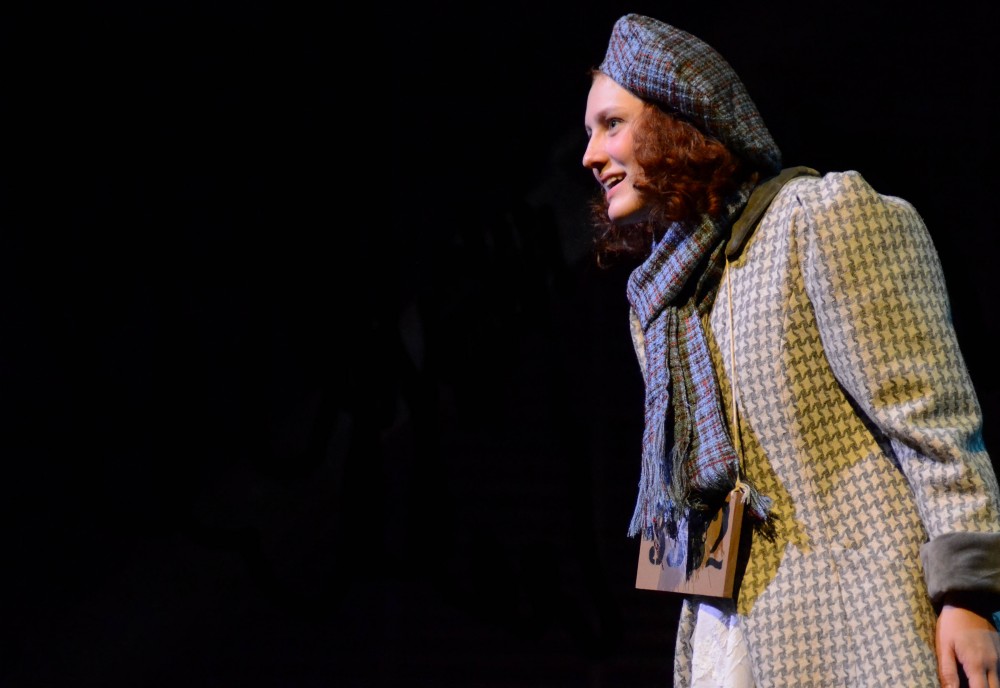Review: Holocaust play sheds light on lasting effects, but lacks clarity

GVL / Hannah Mico. The main character of “Kindertransport,” Eva, is played by Marllory Caillaud-Jones.
Nov 20, 2013
For some, the Holocaust has become little more than a series of facts to be remembered for exams. “Kindertransport,” a play presented by the Grand Valley State University theater department, re-humanizes the Holocaust by depicting the lasting effects it could have had on not just an individual but an entire family.
The play follows the story of a 9-year-old girl named Eva who was shipped from Germany to England in the Kindertransport. This was an effort by the British to save children from Germany, Czechoslovakia and Austria after Kristallnacht, the Night of Broken Glass.
The play switches back and forth from the girl as a young child to the same character as a grown adult with a daughter of her own. This juxtaposition of past and present shows a more complex, real version of the pain induced by the Holocaust.
While the inclusion of the older version of the main character is appreciated, some of the choices the production made leave the audience with a headache after spending the first half of the play figuring out who the characters are and what time period is being depicted.
The stage has a singular, never-changing set, so the different time periods play out with the same backdrop. For the most part, the different time periods are represented on opposite sides of the stage, but this isn’t always consistent, making it difficult to immediately understand which time period a scene was set in.
Perhaps the most confusing aspect of the play is the character of the Ratcatcher. Similar to the Pied Piper, the Ratcatcher is a fictional character that looms in the background of every scene. The only character that is aware of his presence is young Eva.
It can be fairly distracting to look over on the other side of the stage and see young Eva in a chair with the Ratcatcher, in all his caped glory, hunched over the back of the chair, as if he is both protecting and preying on her.
Only at the end of the play, when the rabbi who speaks afterward points it out, is it clear that the Ratcatcher is intended as a metaphor for the ever-present force that is anti-Semitism. However, the interactions with the Ratcatcher and young Eva make the relationship seem more similar to that of a creepy neighbor, a Boo Radley-like character. The metaphor could be much clearer.
The play is set in England as well as a bit in Germany, and the actors do a commendable job of keeping up their accents for the location they are representing. The actress that plays the young Eva even has multiple lines in German.
However, there were a few moments in which the actors would slip out of their accents, drawing the audience out of the scene for just a brief moment.
Some of the most emotional scenes in the play are flashbacks that the older Eva had of herself speaking to her biological mother after the war is over. When these dramatic scenes occur, the lighting abruptly changes to a sickly green.
The green hue emphasizes the break with reality happening during those scenes. Like the green light at the end of the dock in The Great Gatsby, neither Gatsby nor Eva cannot reconnect with their past lives.
The most powerful moments in the play are not the ones with dramatic lighting, however. The true power of this play resides in the brief lines that show just how deeply the Holocaust and Kindertransport changed the lives of those involved.
Eva’s German mother asking what they will do without their daughter there at Passover to ask the four questions traditionally asked by the youngest child of a family is a heart-wrenchng reminder of the pain parents went through when choosing to send their children away without them.
The play is heavy with emotion, and none of that emotion is superficial. The characters and story lend themselves to a deeper consideration of historical events on a personal level. This is aided by incredibly complex female characters. “Kindertransport” passes the Bechdel test, a test to see if two female characters hold a conversation about anything other than a man, with flying colors.
GVSU’s “Kindertransport” was a well-thought out production, with a strong cast. Its plot could have been made clearer and easier for the audience to understand, but the play is worth the time it takes to decipher, particularly if a deeper and more personal understanding of the repercussions of the Holocaust is desired.
The play will be showing for its final weekend on Nov. 21 and 23. Show times and ticket information may be found at http://gvsu.edu/theatre.























